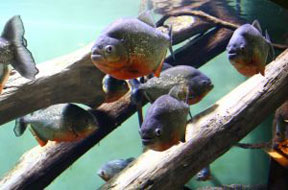Red-breasted piranha
Serrasalmus nattereri
Size is usually 15 to 25 cm long although some specimens have been reported to be up to 43 cm in length. Piranhas are generally flattened from side to side and have a high body; all have an adipose fin. All piranhas have a single row of sharp teeth in both jaws; the teeth are tightly packed and interlocking and are used for rapid puncture and shearing. Individual teeth are typically broadly triangular, pointed, and blade-like.
The sides are olive green to pale brown, in some individuals marked with darker blotches in no particular pattern. Some scales on the sides sparkle in certain light conditions and reflect bright silver or yellow. The back is dark blue-grey or brown. The throat, belly, as well as pectoral, pelvic, and anal fins are bright red in healthy specimens.
Conservation Status: IUCN

Distribution
In South America throughout the rivers of Argentina, Bolivia, Brazil, Colombia, Ecuador, Guyana, Paraguay, Peru, Uruguay, and Venezuela. Individual specimens have been found in the southern U.S. by introduction, although they cannot survive cold winters.
Habitat
They inhabit all types of freshwaters, from quiet and weedy to clear rushing streams.
Diet
Highly predaceous carnivores, but they also scavenge for food and consume insects, snails, worms, plants, and fins of other fishes. Small fishes are their usual diet but injured or dead animals are eagerly devoured. Adults forage mainly at dusk and dawn; smaller fishes feed during the day. They exhibit a "lurking, then dashing" behavior during the day.
Reproduction
One or several pits are dug and these pits and are well guarded by the parents. The female sprays up to 1500 adhesive eggs over the area which is then fertilized by the male. The eggs will hatch in about four days. As the fry grow, they must find enough food or they attack each other.
Adaptation
The slender, muscular tail section of the body and the stiff, blade-shaped lobes of the tail fin help drive the piranha rapidly through the water towards its prey. There are especially thick scales in the area of its head which protect this fish as it butts against a carcass when feeding. The lower jaw extends out past the upper to assist in tearing off bites of food.
Threats to Survival
Although this species is quite common, they are under pressure from a variety of sources. Piranhas are a popular food item and are sold in local markets. In recent decades dried specimens have been sold as tourist souvenirs. Several species of piranha are obtainable in the aquarium trade, the most common being the red-bellied piranha.













